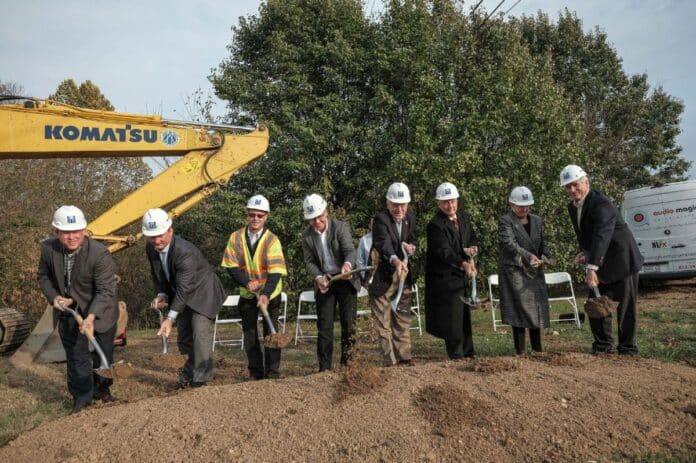
A project nearly four years in the making is now a reality after city, state and railroad officials broke ground for an estimated $35 million railroad overpass on Columbus’ west side.
“We started internally planning for this in January 2016 when we took office, and at that time we came forward with two primary initiatives, one related to substance abuse and the second related to train traffic,” Columbus Mayor Jim Lienhoop told a crowd of just more than 100 people at a groundbreaking ceremony Monday.
Lienhoop recounted the city’s work to establish ASAP, the Alliance for Substance Abuse Progress — as goal No. 1A. A railroad overpass over the State Road 46 and State Road 11 crossing, he said, was goal No. 1B.
“We wanted to be able to have unimpeded ingress and egress through the city of Columbus,” he said. “When we started this project, Dave (Hayward, executive director of public works/city engineer) explained to me that even without a train event, this was still a poorly performing intersection, particularly at peak volume times.”
[sc:text-divider text-divider-title=”Story continues below gallery” ]Click here to purchase photos from this gallery
Currently, 40,000 motorists cross the railroad tracks at this intersection daily. To put it in perspective, an estimated 45,000 people live in Columbus, and 80,000 individuals live in Bartholomew County.
Hayward said construction for the railroad overpass is scheduled to begin later this month.
“It’s satisfying to know we worked our way through a process that was very accelerated and got to the finish line on schedule,” Hayward said.
The new overpass and cloverleaf interchange on the west side at State Road 46 and State Road 11 will allow motorists to avoid being slowed or stopped because of increasing railroad traffic projected to occur on the Louisville & Indiana Railroad tracks which pass through Columbus.
Louisville & Indiana has leased the tracks to CSX, and, after a massive rail improvement project, is planning to run high-speed rail on the line from Louisville to Indianapolis.
Fulfilling a need
Louisville & Indiana Railroad officials earlier notified the city that longer, heavier and faster CSX trains will begin traveling through Columbus on L&I’s rail system beginning this month.
Louisville & Indiana Railroad and CSX Transportation won approval in April 2015 from the federal Surface Transportation Board to use L&I’s 106-mile mainline between Louisville and Indianapolis jointly and upgrade it from jointed steel rails to continuous welded ones.
The new rails allows heavier and faster trains to move through Columbus and other cities along the rail line. The plan calls for CSX, which would invest $70 million to $90 million in improvements, to shift an estimated 13 to 15 trains per day to the L&I line, in addition to the L&I trains.
Examining the railroads’ plan, the federal agency’s Office of Environmental Analysis said the project would not significantly affect communities along the rail line.
However, mayors in cities along the railroad strongly disagreed, and Columbus officials began looking for an alternative fix.
A 2016 study by Indianapolis engineering firm American Structurepoint Inc., commissioned by the city, indicates as many as 22 trains may travel through the State Road 46/State Road 11 intersection, and other Columbus downtown intersections.
If there is a near constant presence of trains on the downtown tracks, it will mean inconvenience for people who want to access Mill Race Park, Mill Race Center or the city bus depot, all on the west side of the tracks from Lindsey Street, city officials said.
“What we have here is a traffic funnel,” Lienhoop said. “Because of the geography, most of the traffic coming in and out of the city comes through this intersection.”
One-third of Columbus residents live on the city’s west side. When a train travels through the State Road 46 and State Road 11 intersection, the entire west side is cut off from a hospital, schools, downtown Columbus and more entities that make a city, a city, Lienhoop said.
Details of the project
Substantial completion of the overpass project is expected by the end of 2020. Hayward said earlier that landscaping and other finishing work will continue through 2021.
Work will begin this month when Milestone Contractors, who won the contract, removes several hundred trees from the construction site. This includes about 66 trees on the south side of the project and the trees along the railroad tracks.
While those trees are being removed, the project calls for 2,184 trees be planted as replacements. More than 600 of those trees are in the infill areas around the cloverleaf, including the south side of the project, Hayward said.
The overpass will clear the railroad tracks by 23 feet to accommodate the 22 or more additional trains that are expected to travel through the city daily.
Approximately 31,200 tons of new asphalt and 4,600 tons of recycled asphalt will be used for the project, and about 460,000 cubic yards of dirt will be poured at the site — equaling around 50,000 truck loads, said Mark Thompson, vice president of Milestone Contractors.
Columbus City Council members in October authorized the Columbus Redevelopment Commission to transfer $4.6 million in Central TIF District funds to a city-run pool of money that has been dispersing the local portion of funding for the project to the Indiana Department of Transportation, who is overseeing the project.
Initially, INDOT’s cost estimate for the project was $30 million, and the city is responsible for putting together half of the project’s cost, or $15 million, according to the terms of an interlocal agreement between the city and INDOT. The state will pay for the other half of the project’s costs.
However, in September, INDOT raised its construction cost estimate for the project from $30 million to $35.3 million, raising the city’s share from $15 million to around $17.6 million.
The increased cost estimate accounts for right-of-way acquisition costs that were higher than expected and rising construction costs.
The city has partnered with Cummins Inc., Bartholomew County and the Louisville & Indiana and CSX Railroads to defray around half of the local funding requirements in the interlocal agreement, city officials said.
Bartholomew County will pay $1.5 million to the city and another $500,000 that will be paid over a two-year period. The city’s share will include $4 million from Central TIF District funds, while other funding sources include about $5.5 million from the Cummins Engine Plant TIF District funds, up to $2.5 million in state or federal highway programs along with cost savings and $1.5 million from CSX and Louisville & Indiana Railroads.
Redevelopment director Heather Pope said the entire $4.6 million will come from the Central TIF District, raising the total amount from the Central TIF District to $8.6 million, or roughly 25% of the project’s total cost.
The city council is expected to take up the appropriation of funds for the railroad overpass project during its meetings on Wednesday and Nov. 19.
As construction begins on the overpass, west-side motorists are being advised to consider using County Road 325W and Lowell Road, a bypass that goes into southbound U.S. 31 and into the city’s business district on National Road.
Bartholomew County’s highway crews spent $200,000 to significantly soften two sharp curves on Lowell Road. That allowed the speed limit to be raised from 20 to 40 mph in that area in anticipation of both Lowell and 325W being used to avoid long waits for trains.
[sc:pullout-title pullout-title=”Where to learn more” ][sc:pullout-text-begin]
To learn more about the railroad overpass project, visit columbusrailroadproject.org.
[sc:pullout-text-end]




